Charles E W Bean, Diaries, AWM38 3DRL 606/251/1 - 1915 - 1936 - Part 1

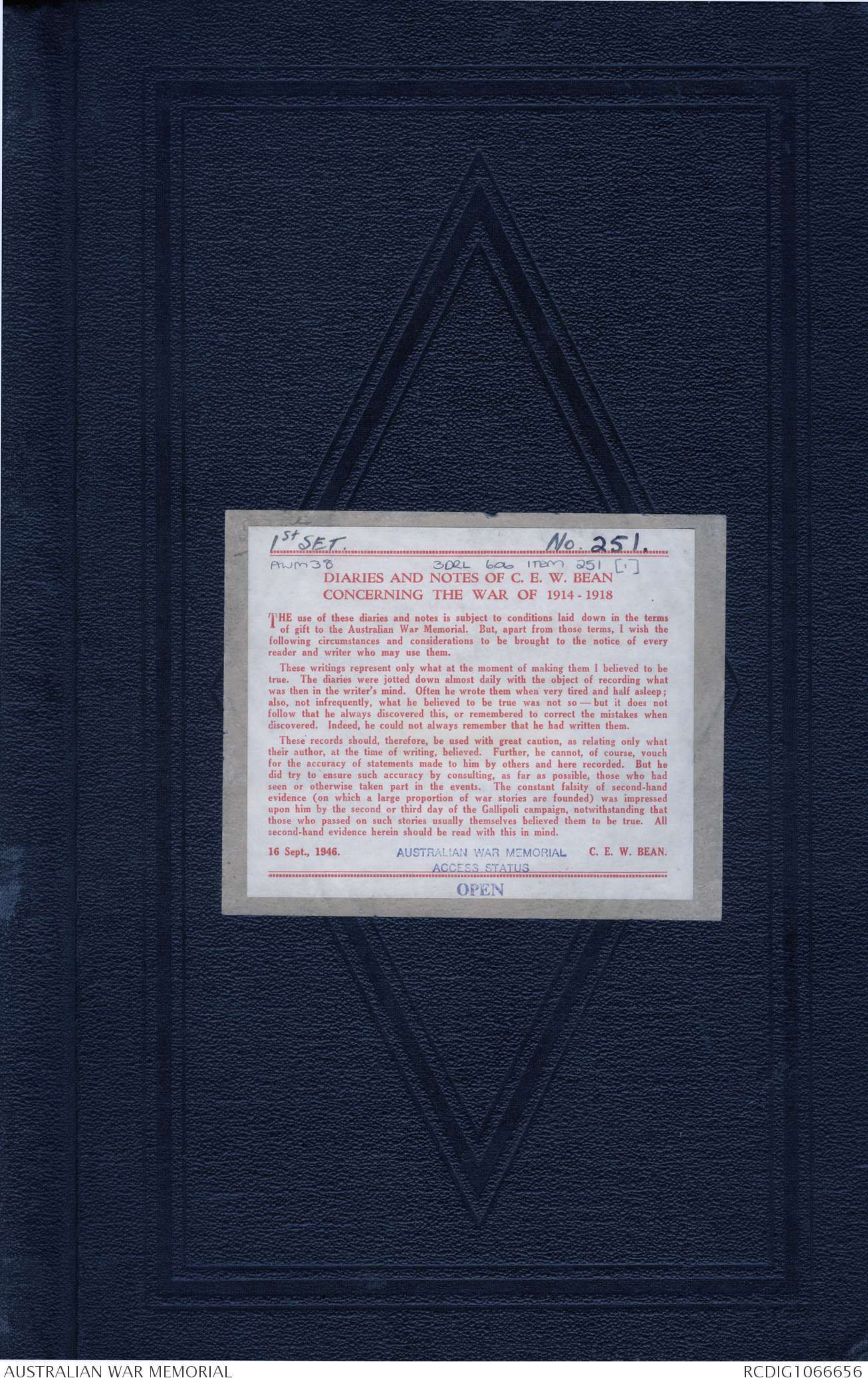
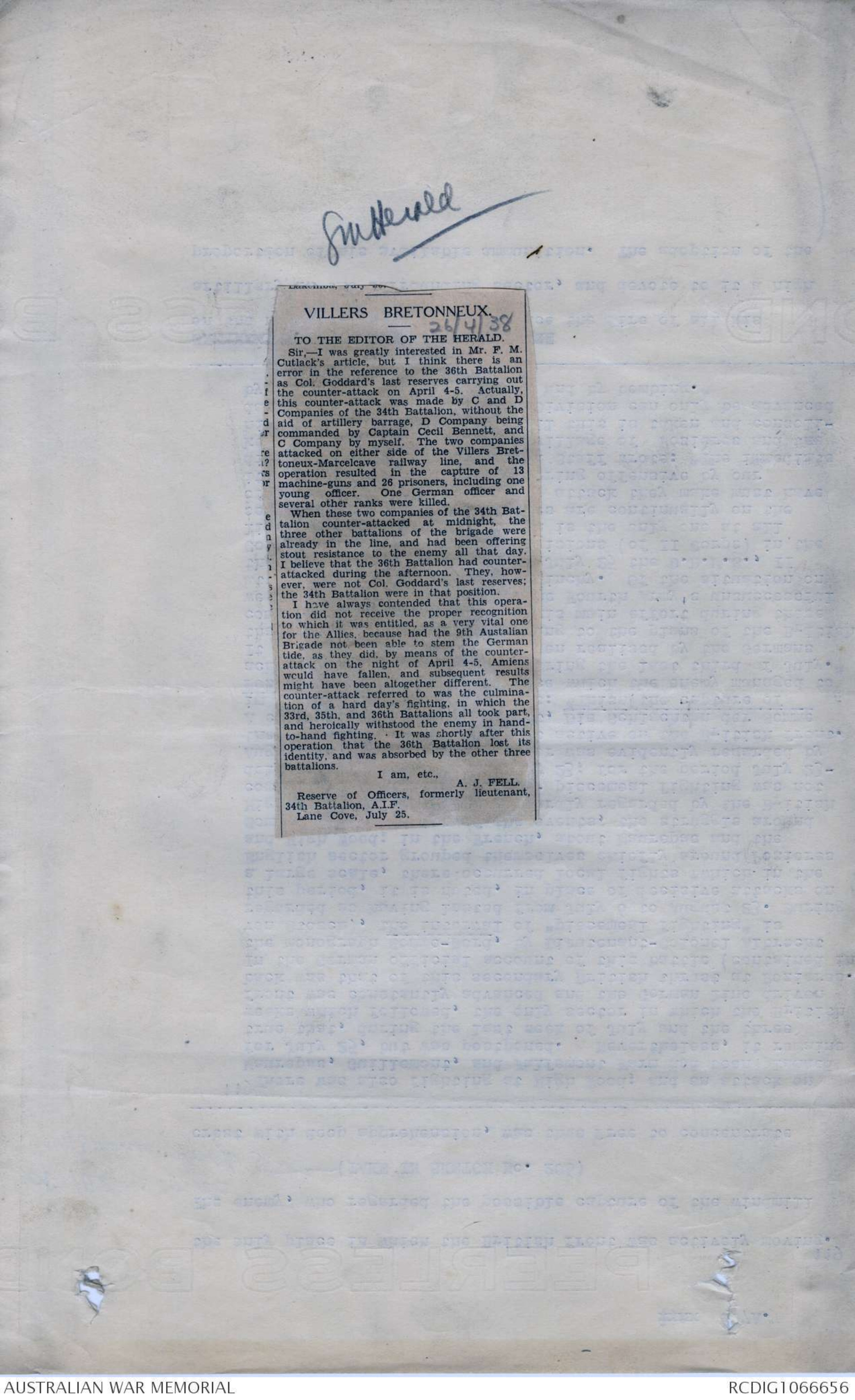
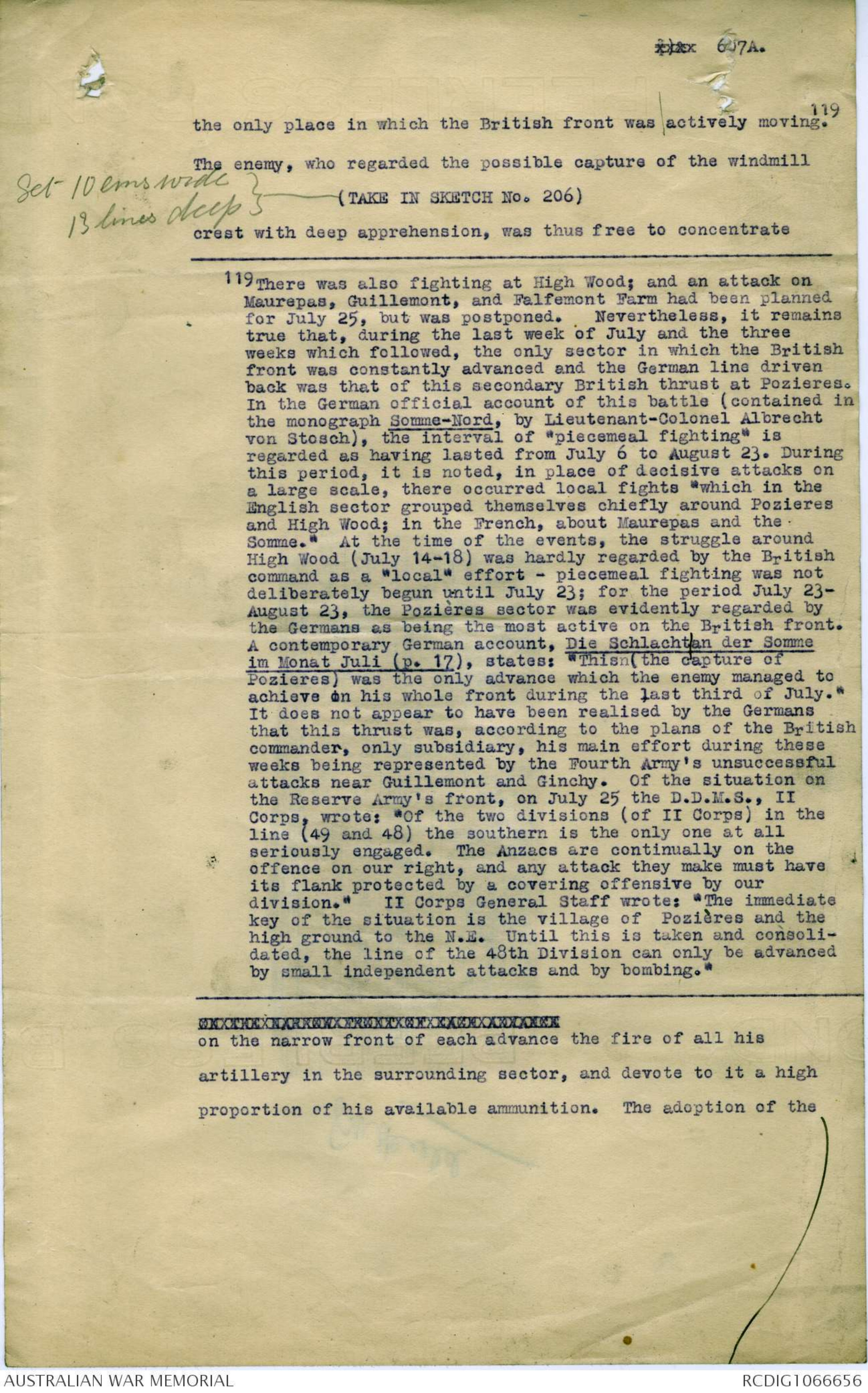
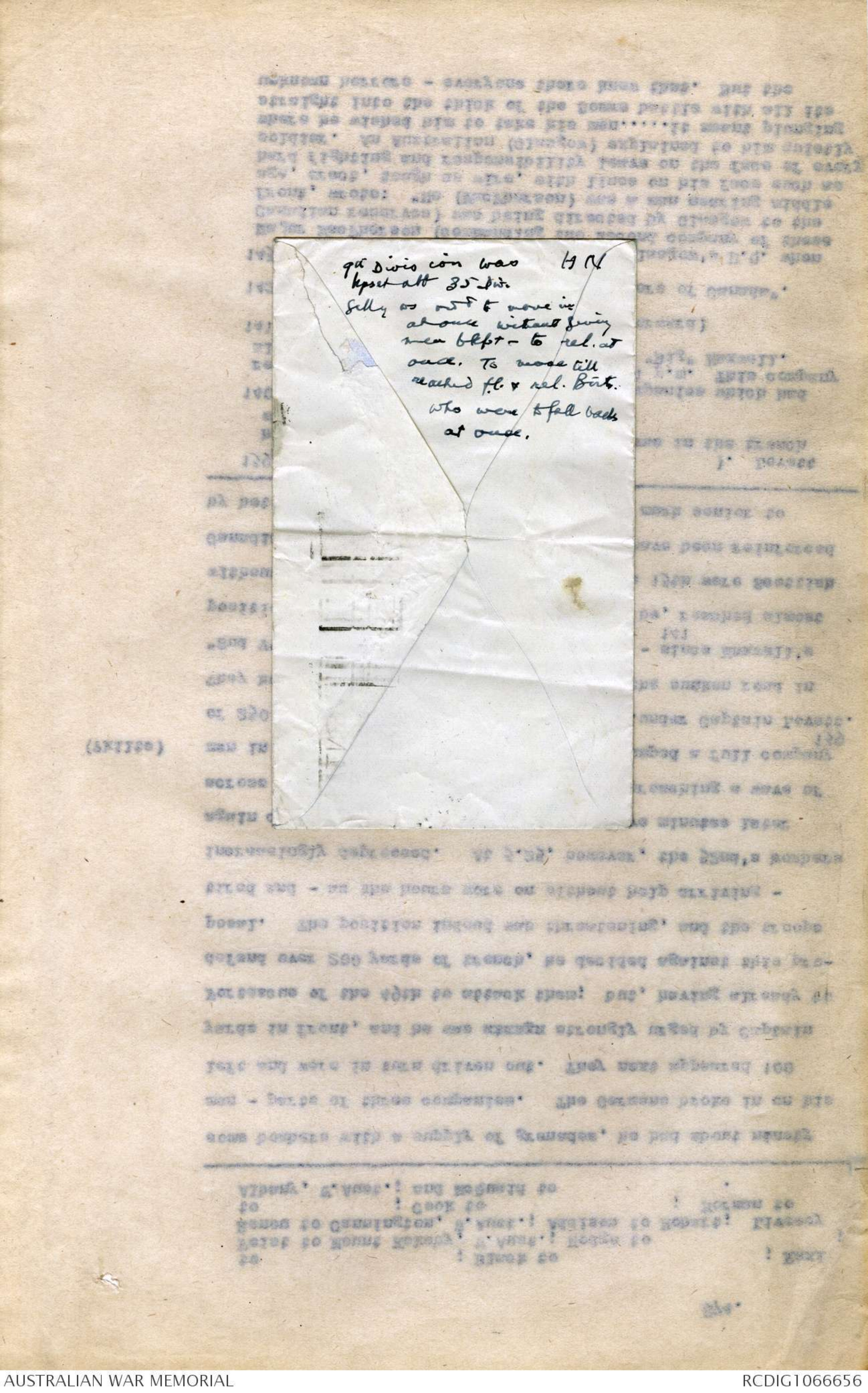
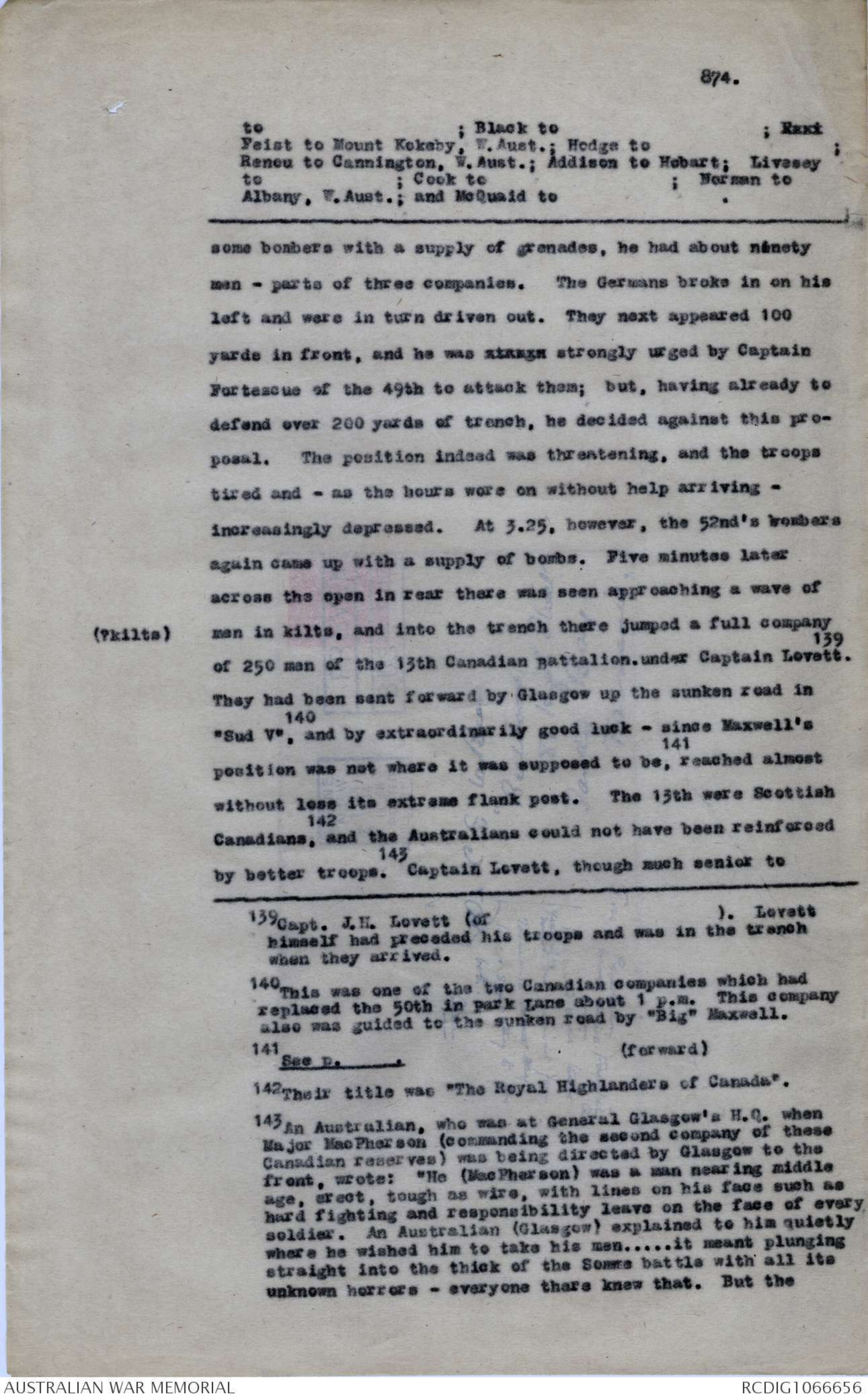
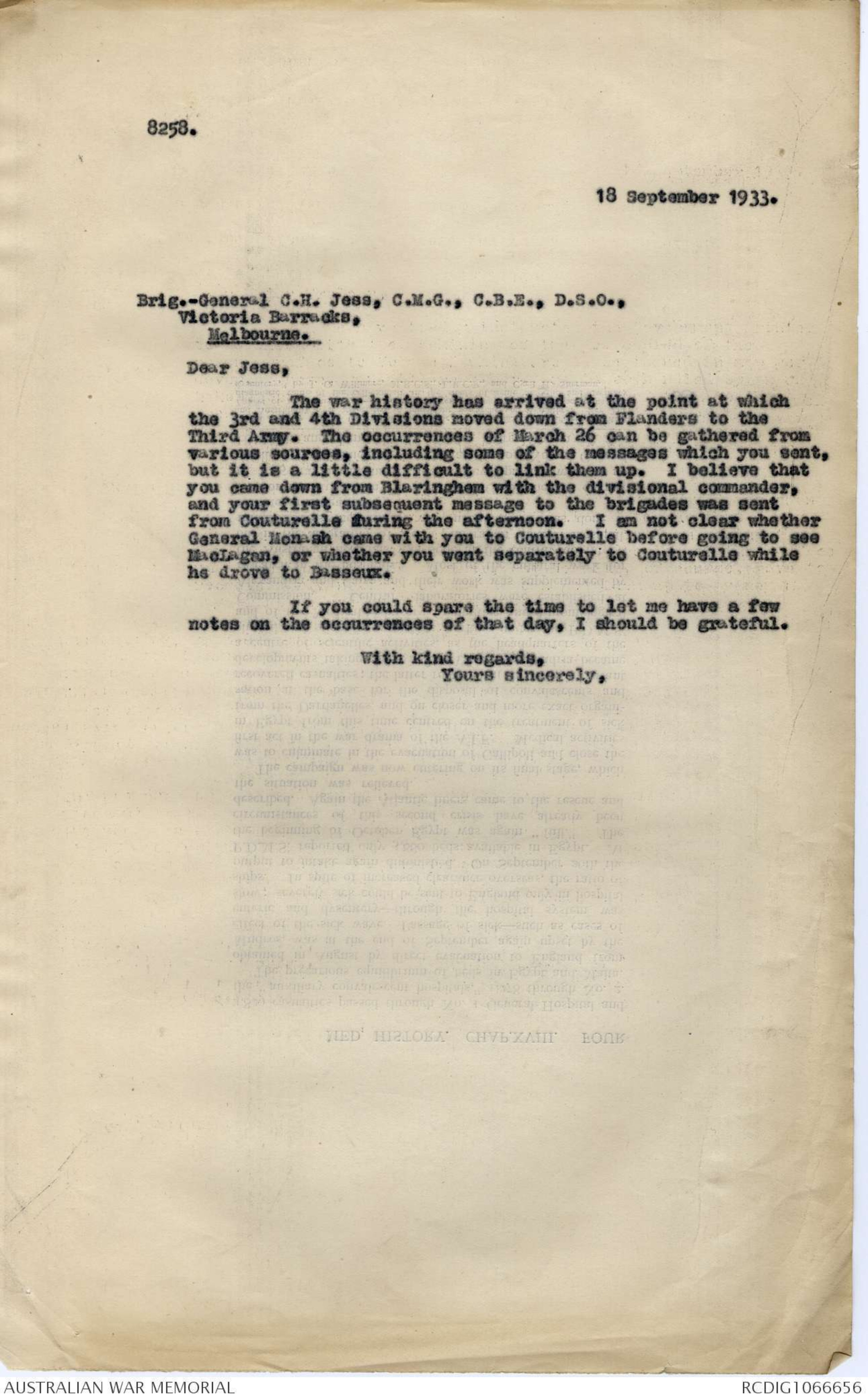
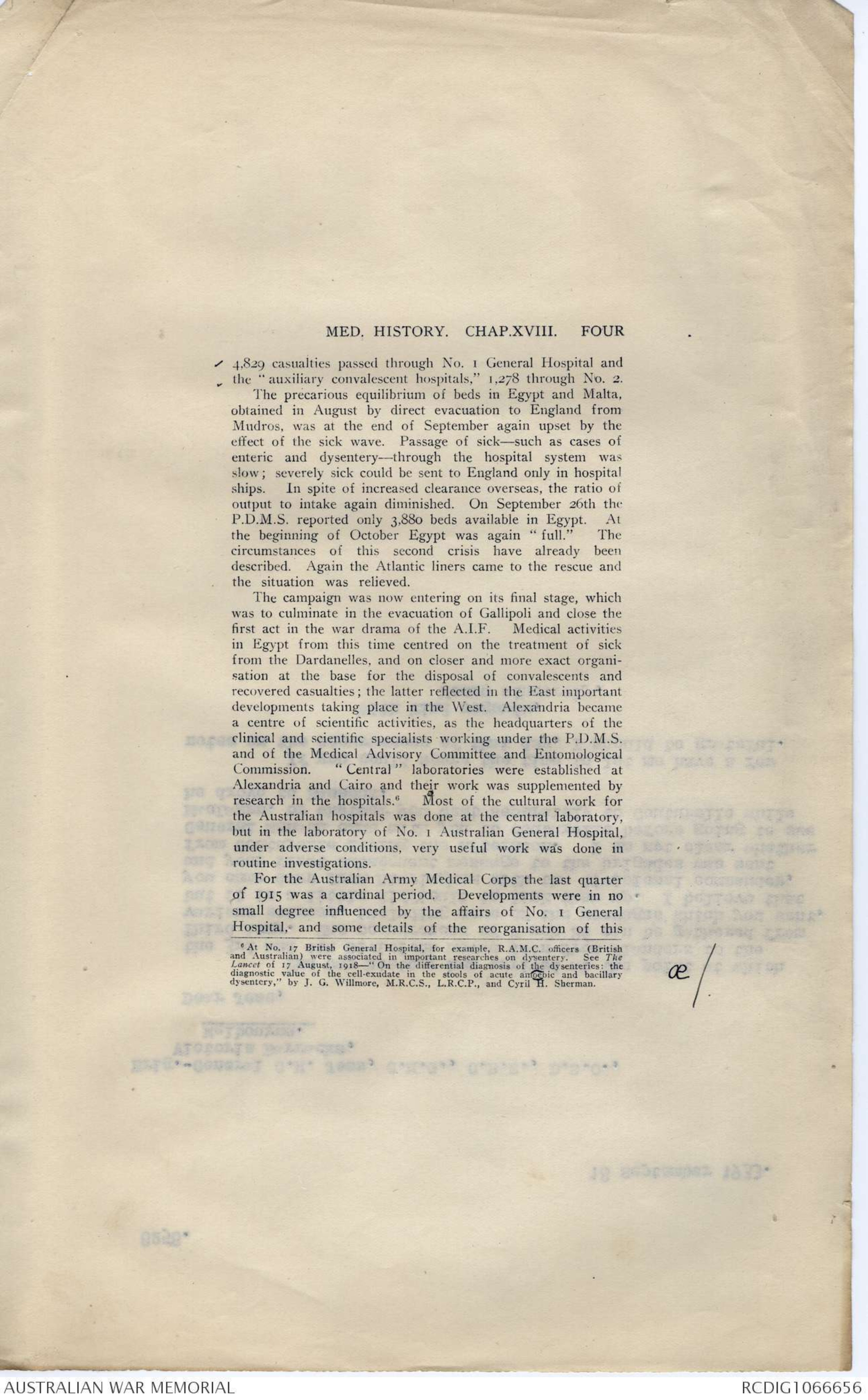
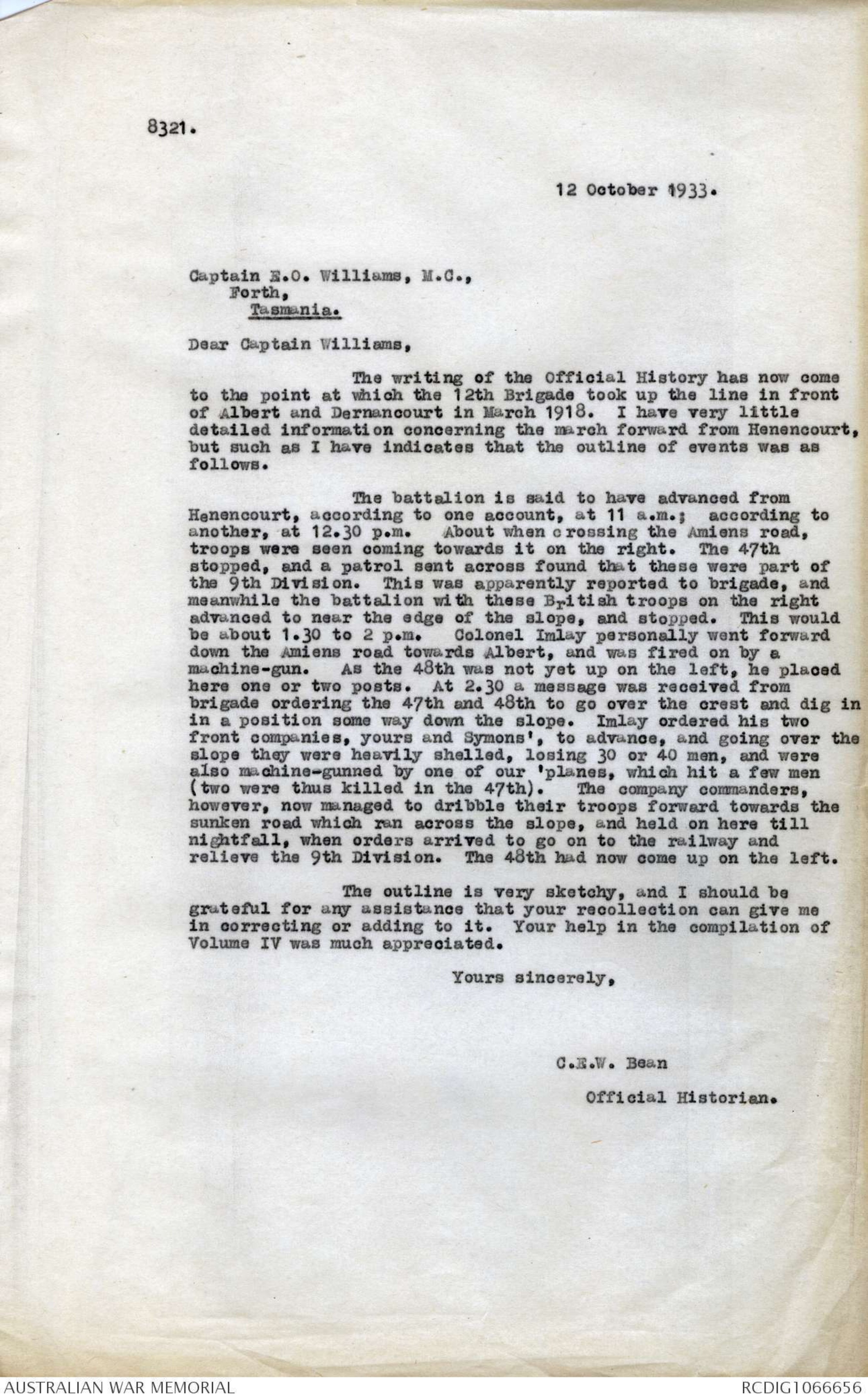
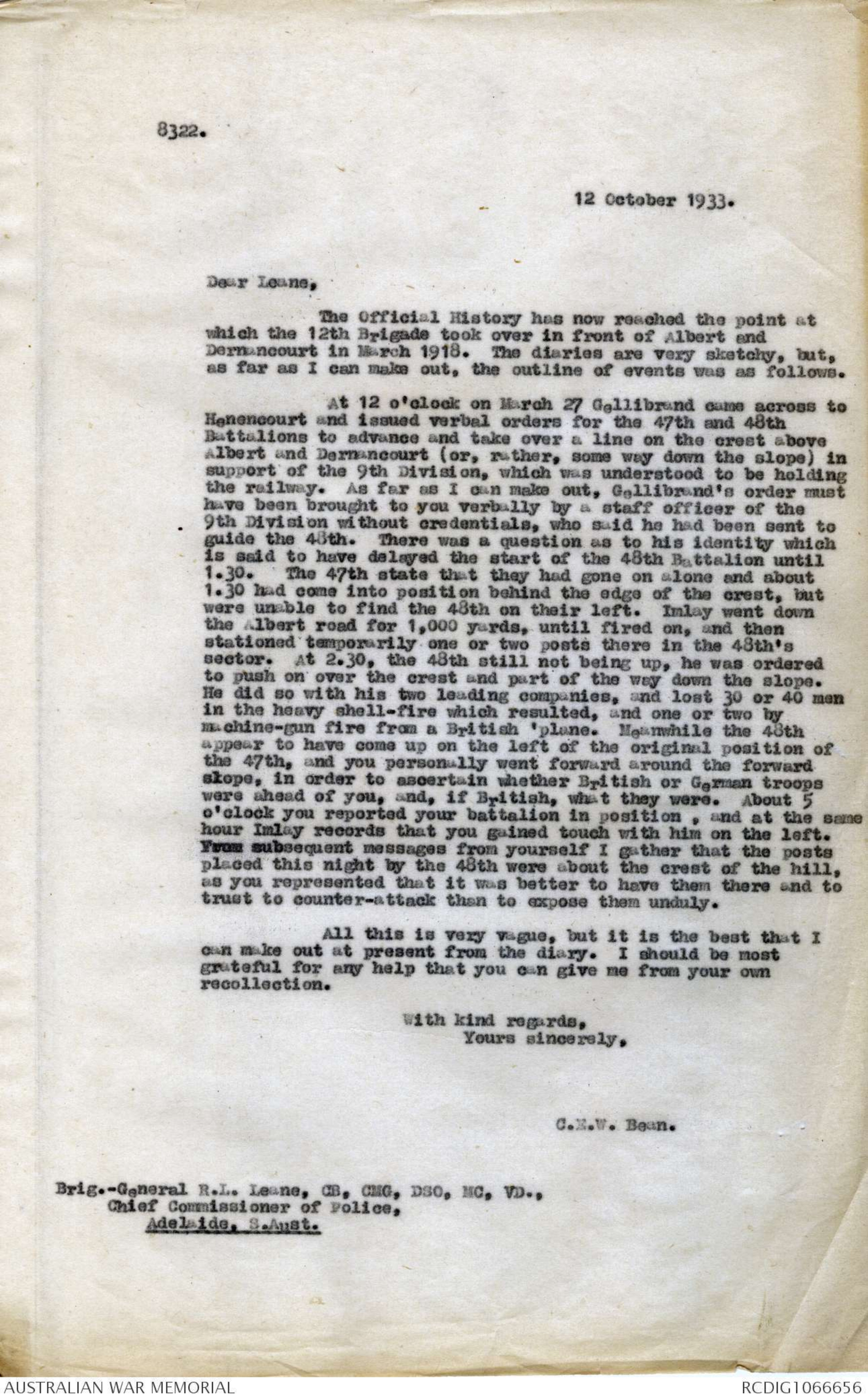
AWM38
Official History,
1914-18 War: Records of C E W Bean,
Official Historian.
Diaries and Notebooks
Item number: 3DRL606/251/1
Title: Folder, 1915 - 1936
Comprises various papers on the German
offensive of March-April 1918, including notes by
Bean and letters by Lt Col G F G Wieck and Brig
Gen R L Leane.
AWM38-3DRL606/251/1
1st SET. No 251.
AWM38
3DRL 606 ITEM 251 [1]
DIARIES AND NOTES OF C. E. W. BEAN
CONCERNING THE WAR OF 1914-1918
THE use of these diaries and notes is subject to conditions laid down in the terms
of gift to the Australian War Memorial. But, apart from those terms, I wish the
following circumstances and considerations to be brought to the notice of every
reader and writer who may use them.
These writings represent only what at the moment of making them I believed to be
true. The diaries were jotted down almost daily with the object of recording what
was then in the writer's mind. Often he wrote them when very tired and half asleep;
also, not infrequently, what be believed to be true was not so –but it does not
follow that he always discovered this, or remembered to correct the mistakes when
discovered. Indeed, he could not always remember that he had written them.
These records should, therefore, be used with great caution, as relating only what
their author, at the time of writing, believed. Further, he cannot, of course, vouch
for the accuracy of statements made to him by others and here recorded. But he
did try to ensure such accuracy by consulting, as far as possible, those who had
seen or otherwise taken part in the events. The constant falsity of second-hand
evidence (on which a large proportion of war stories are founded) was impressed
upon him by the second or third day of the Gallipoli campaign, notwithstanding that
those who passed on such stories usually themselves believed them to be true. All
second-hand evidence herein should be read with this in mind.
16 Sept., 1946.
C. E. W. BEAN.
AUSTRALIAN WAR MEMORIAL
ACCESS STATUS
OPEN
Sun Herald
VILLERS BRETONNEUX.
26/4/38
TO THE EDITOR OF THE HERALD.
Sir,—I was greatly interested in Mr. F. M.
Cutlack's article, but I think there is an
error in the reference to the 36th Battalion
as Col. Goddard's last reserves carrying out
the counter-attack on April 4-5. Actually,
this counter-attack was made by C and D
Companies of the 34th Battalion, without the
aid of artillery barrage, D Company being
commanded by Captain Cecil Bennett, and
C Company by myself. The two companies
attacked on either side of the Villers
Brettoneux-Marcelcave railway line, and the
operation resulted in the capture of 13
machine-guns and 26 prisoners, including one
young officer. One German officer and
several other ranks were killed.
When these two companies of the 34th Battalion
counter-attacked at midnight, the
three other battalions of the brigade were
already in the line, and had been offering
stout resistance to the enemy all that day.
I believe that the 36th Battalion had counter-attacked
during the afternoon. They, however,
were not Col. Goddard's last reserves;
the 34th Battalion were in that position.
I have always contended that this operation
did not receive the proper recognition
to which it was entitled, as a very vital one
for the Allies, because had the 9th Australian
Brigade not been able to stem the German
tide, as they did, by means of the counter-attack
on the night of April 4-5, Amiens
would have fallen, and subsequent results
might have been altogether different. The
counter-attack referred to was the culmination
of a hard day's fighting, in which the
33rd, 35th and 36th Battalions all took part,
and heroically withstood the enemy in hand-to-hand
fighting. It was shortly after this
operation that the 36th Battalion lost its
identity, and was absorbed by the other three
battalions.
I am, etc.,
A. J. FELL.
Reserve of Officers, formerly lieutenant,
34th Battalion, A.I.F
Lane Cove, July 25.
xxxx 607A.
the only place in which the British front was actively moving.119
The enemy, who regarded the possible capture of the windmill
[*Set 10 ems wide} (TAKE IN SKETCH No. 206)
13 lines deep *}
crest with deep apprehension, was thus free to concentrate
________________________________________________
119 There was also fighting at High Wood; and an attack on
Maurepas, Guillemont, and Falfemont Farm had been planned
for July 25, but was postponed. Nevertheless, it remains
true that, during the last week of July and the three
weeks which followed, the only sector in which the British
front was constantly advanced and the German line driven
back was that of this secondary British thrust at Pozieres.
In the German official account of this battle (contained in
the monograph Somme-Nord, by Lieutenant-Colonel Albrecht
von Stosch), the interval of "piecemeal fighting" is
regarded as having lasted from July 6 to August 23. During
this period, it is noted, in place of decisive attacks on
a large scale, there occurred local fights "which in the
English sector grouped themselves chiefly around Pozieres
and High Wood; in the French, about Maurepas and the.
Somme." At the time of the events, the struggle around
High Wood (July 14-18) was hardly regarded by the British
command as a "local" effort - piecemeal fighting was not
deliberately begun until July 23; for the period July 23-
August 23, the Pozières sector was evidently regarded by
the Germans as being the most active on the British front.
A contemporary German account, Die Schlacht an der Somme
im Monat Juli (p. 17), states: "This (the capture of
Pozieres) was the only advance which the enemy managed to
achieve in his whole front during the last third of July."
It does not appear to have been realised by the Germans
that this thrust was, according to the plans of the British
commander, only subsidiary, his main effort during these
weeks being represented by the Fourth Army's unsuccessful
attacks near Guillemont and Ginchy. Of the situation on
the Reserve Army's front, on July 25 the D.D.M.S.,
II Corps, wrote: "Of the two divisions (of II Corps) in the
line (49 and 48) the southern is the only one at all
seriously engaged. The Anzacs are continually on the
offence on our right, and any attack they make must have
its flank protected by a covering offensive by our
division." II Corps General Staff wrote: "The immediate
key of the situation is the village of Pozières and the
high ground to the N.E. Until this is taken and consolidated,
the line of the 48th Division can only be advanced
by small independent attacks and by bombing."
________________________________________ON THE NARROW FRONT OF EACH ADVANCE
on the narrow front of each advance the fire of all his
artillery in the surrounding sector, and devote to it a high
proportion of his available ammunition. The adoption of the
HN
9th Division was
upset abt 35 Div.
Gelly ws not to move in
at once without giving
men bkft- to rel. at
once. To move till
reached f.l. & rel. Brits.
who were to fall back
at once.
874.
to ; Black to ; Exxi
Feist to Mount Kokeby, W. Aust.; Hedge to ;
Reneu to Cannington, W. Aust.; Addison to Hobart; Livesey
to ; Cook to ; Norman to
Albany, W. Aust.; and McQuaid to .
________________________________________________
some bombers with a supply of grenades, he had about ninety
men - parts of three companies. The Germans broke in on his
left and were in turn driven out. They next appeared 100
yards in front, and he was stxxgx strongly urged by Captain
Fortescue of the 49th to attack them; but, having already to
defend over 200 yards of trench, he decided against this proposal.
The position indeed was threatening, and the troops
tired and - as the hours wore on without help arriving -
increasingly depressed. At 3.25, however, the 52nd's bombers
again came up with a supply of bombs. Five minutes later
across the open in rear there was seen approaching a wave of
[*(?kilts)*] men in kilts, and into the trench there jumped a full company
of 250 men of the 13th Canadian Battalion. under Captain Lovett.139
They had been sent forward by Glasgow up the sunken road in
"Sud V",140 and by extraordinarily good luck - since Maxwell's
position was not where it was supposed to be,141 reached almost
without loss its extreme flank post. The 13th were Scottish
Canadians,142 and the Australians could not have been reinforced
by better troops.143 Captain Lovett, though much senior to
_______________________________________________
139 Capt. J. H. Lovett (of ). Lovett
himself had preceded his troops and was in the trench
when they arrived.
140 This was one of the two Canadian companies which had
replaced the 50th in Park Lane about 1 p.m. This company
also was guided to the sunken road by "Big" Maxwell.
141 See p. . (forward)
142 Their title was "The Royal Highlanders of Canada".
143 An Australian, who was at General Glasgow's H.Q. when
Major MacPherson (commanding the second company of these
Canadian reserves) was being directed by Glasgow to the
front, wrote: "He (MacPherson) was a man nearing middle
age, erect, tough as wire, with lines on his face such as
hard fighting and responsibility leave on the face of every
soldier. An Australian (Glasgow) explained to him quietly
where he wished him to take his men.....it meant plunging
straight into the thick of the Somme battle with all its
unknown horrors - everyone there knew that. But the
8258.
18 September 1933.
Brig.-General C.H. Jess, C.M.G., C.B.E., D.S.O.,
Victoria Barracks,
Melbourne.
Dear Jess,
The war history has arrived at the point at which
the 3rd and 4th Divisions moved down from Flanders to the
Third Army. The occurrences of March 26 can be gathered from
various sources, including some of the messages which you sent,
but it is a little difficult to link them up. I believe that
you came down from Blaringhem with the divisional commander,
and your first subsequent message to the brigades was sent
from Couturelle during the afternoon. I am not clear whether
General Monash came with you to Couturelle before going to see
MacLagan, or whether you went separately to Couturelle while
he drove to Basseux.
If you could spare time to let me have a few
notes on the occurrences of that day, I should be grateful.
With kind regards,
Yours sincerely,
MED. HISTORY, CHAP.XVIII. FOUR
4,829 casualties passed through No. 1 General Hospital and
the "auxiliary convalescent hospitals," 1278 through No. 2.
The precarious equilibrium of beds in Egypt and Malta,
obtained in August by direct evacuation to England from
Mudros, was at the end of September again upset by the
effect of the sick wave. Passage of sick—such as cases of
enteric and dysentery—through the hospital system was
slow; severely sick could be sent to England only in hospital
ships. In spite of increased clearance overseas, the ratio of
output to intake again diminished. On September 26th the
P.D. M.S. reported only 3,880 beds available in Egypt. At
the beginning of October Egypt was again "full." The
circumstances of this second crisis have already been
described. Again the Atlantic liners came to the rescue and
the situation was relieved.
The campaign was now entering on its final stage, which
was to culminate in the evacuation of Gallipoli and close the
first act in the war drama of the A.I.F. Medical activities
in Egypt from this time centred on the treatment of sick
from the Dardanelles, and on closer and more exact organisation
at the base for the disposal of convalescents and
recovered casualties; the latter reflected in the East important
developments taking place in the West. Alexandria became
a centre of scientific activities, as the headquarters of the
clinical and scientific specialists working under the P.D.M.S.
and of the Medical Advisory Committee and Entomological
Commission. "Central" laboratories were established at
Alexandria and Cairo and their work was supplemented by
research in the hospitals.".6 Most of the cultural work for
the Australian hospitals was done at the central laboratory,
but in the laboratory of No. 1 Australian General Hospital,
under adverse conditions, very useful work was done in
routine investigations.
For the Australian Army Medical Corps the last quarter
of 1915 was a cardinal period. Developments were in no
small degree influenced by the affairs of No. 1 General
Hospital, and some details of the reorganisation of this
_______________________________________________
6At No. 17 British General Hospital, for example, R.A.M.C. officers (British
and Australian) were associated in important researches on dysentery. See The
Lancet of 17 August, 1918—"On the differential diagnosis of the dysenteries: the
diagnostic value of the cell-exudate in the stools of acute amoebic and bacillary [*œ/*]
dysentery," by J. G. Willmore, M.R.C.S, L.R.C.P., and Cyril H. Sherman.
8321.
12 October 1933
Captain E.O. Williams, M.C.,
Forth,
Tasmania.
Dear Captain Williams,
The writing of the Official History has now come
to the point at which the 12th Brigade took up the line in front
of Albert and Dernancourt in March 1918. I have very little
detailed information concerning the march forward from Henencourt,
but such as I have indicates that the outline of events was as
follows.
The battalion is said to have advanced from
Henencourt, according to one account, at
11 a.m.; according to
another, at 12.30 p.m. About when crossing the Amiens road,
troops were seen coming towards it on the right. The 47th
stopped, and a patrol sent across found that these were part of
the 9th Division. This was apparently reported to brigade, and
meanwhile the battalion with these British troops on the right
advanced to near the edge of the slope, and stopped. This would
be about 1.30 to 2 p.m. Colonel Imlay personally went forward
down the Amiens road towards Albert, and was fired on by a
machine-gun. As the 48th was not yet up on the left, he placed
here one or two posts. At 2.30 a message was received from
brigade ordering the 47th and 48th to go over the crest and dig in
in a position some way down the slope. Imlay ordered his two
front companies, yours and Symons', to advance, and going over the
slope they were heavily shelled, losing 30 or 40 men, and were
also machine-gunned by one of our 'planes, which hit a few men
(two were thus killed in the 47th). The company commanders,
however, now managed to dribble their troops forward towards the
sunken road which ran across the slope, and held on here till
nightfall, when orders arrived to go on to the railway and
relieve the 9th Division. The 48th had now come up on the left.
The outline is very sketchy, and I should be
grateful for any assistance that your recollection can give me
in correcting or adding to it. Your help in the compilation of
Volume IV was much appreciated.
Yours sincerely,
C.E.W. Bean
Official Historian.
8322.
12 October 1933.
Dear Leane,
The Official History has now reached the point at
which the 12th Brigade took over in front of Albert and
Dernancourt in March 1918. The diaries are very sketchy, but,
as far as I can make out, the outline of events was as follows.
At 12 o'clock on March 27 Gellibrand came across to
Henencourt and issued verbal orders for the 47th and 48th
Battalions to advance and take over a line on the crest above
Albert and Dernancourt (or, rather, some way down the slope) in
support of the 9th Division, which was understood to be holding
the railway. As far as I can make out, Gellibrand's order must
have been brought to you verbally by a staff officer of the
9th Division without credentials, who said he had been sent to
guide the 48th. There was a question as to his identity which
is said to have delayed the start of the 48th Battalion until
1.30. The 47th state that they had gone on alone and about
1.30 had come into position behind the edge of the crest, but
were unable to find the 48th on their left. Imlay went down
the Albert road for 1,000 yards, until fired on, and then
stationed temporarily one or two posts there in the 48th's
sector. At 2.30, the 48th still not being up, he was ordered
to push on over the crest and part of the way down the slope.
He did so with his two leading companies, and lost 30 or 40 men
in the heavy shell-fire which resulted, and one or two by
machine-gun fire from a British 'plane. Meanwhile the 48th
appear to have come up on the left of the original position of
the 47th, and you personally went forward around the forward
slope, in order to ascertain whether British or German troops
were ahead of you, and, if British, what they were. About
5 o'clock you reported your battalion in position, and at the same
hour Imlay records that you gained touch with him on the left.
From subsequent messages from yourself I gather that the posts
placed this night by the 48th were about the crest of the hill,
as you represented that it was better to have them there and to
trust to counter-attack than to expose them unduly.
All this is very vague, but it is the best that I
can make out at present from the diary. I should be most
grateful for any help that you can give me from your own
recollection.
with kind regards.
Yours sincerely,
C.E.W. Bean.
Brig.-General R.L. Leane, CB, CMG, DSO. MC. VD.,
Chief Commissioner of Police,
Adelaide, S.Aust.
 Sam scott
Sam scottThis transcription item is now locked to you for editing. To release the lock either Save your changes or Cancel.
This lock will be automatically released after 60 minutes of inactivity.